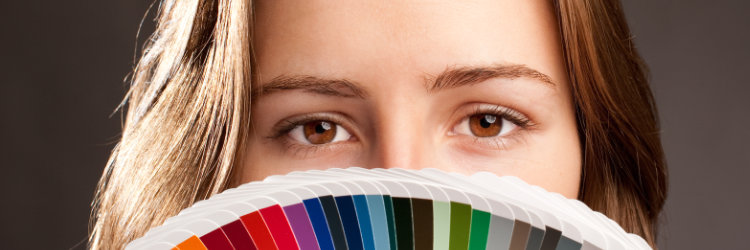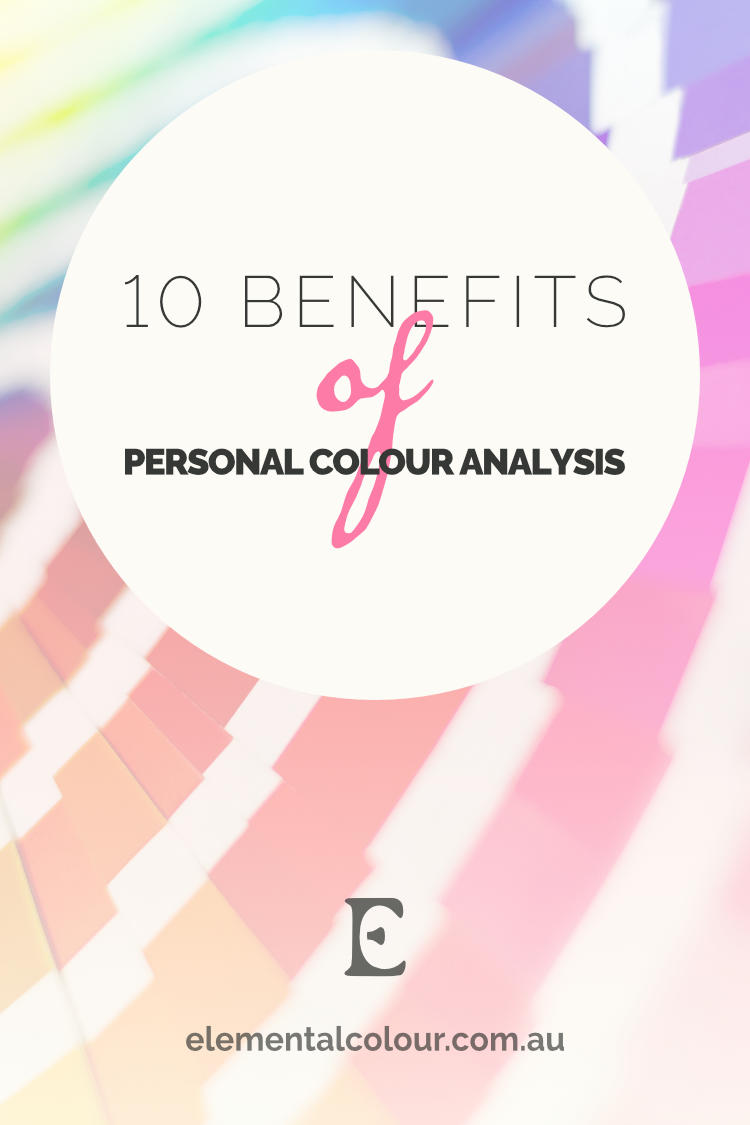10 Benefits of Personal Colour Analysis
A Personal Colour Analysis is the way to find out your most harmonious colours.
Ok… but why would you want to?
What does knowing and wearing your best colours do for you?
I can (and sometimes do) go on for hours about this subject, but I’ll try to spare you the ranting and simply give you my top 10 benefits of Personal Colour Analysis.
10. Declutter your wardrobe
Do you buy clothes that you wear once or twice, and then simply clutter up your wardrobe? Most people wear only a small percentage of their clothes regularly.
Do you ever pick up an item from your wardrobe and just feel uncomfortable about it, but you can’t explain why? It’s likely that the colour is disharmonious with you.
You’ll feel a bit uncomfortable seeing yourself in it, and so will everyone else who looks at you. They won’t know why, but that’s the effect disharmony has.
When you know your colours you won’t accidentally buy something wrong for you, and then wonder why you don’t end up wearing it.
Your wardrobe may well be smaller, but you’ll actually have more to wear.
9. Shopping is quicker and easier
One of the reasons many of us end up with wardrobes full of black is because black is an easy decision to make.
It’s safe.
It may not do anything for our appearance, but we don’t have to think about it too much. (And don’t we all have enough to think about?)
If you’re choosing colours instead, what criteria do you use?
Do I like this colour? Will it go with anything else I own? Does it look good on me? How do I know?
Black just seems easier.
Knowing your best colours gives you a better alternative.
You don’t have to sort through hundreds of items in a store and decide item-by-item whether it’s worth trying on (I feel exhausted just thinking about that). Simply find the ones in your colours, and choose from them.
Reducing the number of decisions you need to make will reduce your stress levels and improve the decisions you do make.
8. Save money
When you know how to choose clothes you will actually wear, you won’t need to buy so many items to luck into a few that work. All those clothes you don’t buy? That’s money saved.
Do you ever buy makeup, wear it once, and then put in the back of your makeup drawer? No more random (and expensive) experimentation — know your colours and you will use the things you buy, and not have to keep buying more to try and find something that works.
7. Getting dressed is quicker and easier
Again, the big benefit here is reducing the number of decisions you need to make.
You don’t need to wonder if this-colour-top goes with that-colour-pants and those-colour-shoes.
You don’t need to try them all on, decide it doesn’t work, try something else, and something else, and then settle for the first outfit after all. (I remember that game and I’m very glad I don’t have to play it anymore!)
When all of your clothes are in your colours, they just all go together. No guesswork, no agonising.
6. Look slimmer
Disharmonious colours can add apparent weight in a couple of ways.
A colour that is brighter or darker than you are can draw the eye down to your clothes instead of up to your face. The more our eyes move downwards the shorter we will perceive you to be, and therefore proportionally wider.
Weird but true.
A colour that is more intense than you can come forward and look larger whereas you can recede and look smaller by comparison.
The trick here is that the place you wear clothes (ie. your body) looks larger, and the place you don’t (ie. your face) looks smaller, and that’s just not a flattering optical illusion.
(See Why the Colours You Wear Change How You Look for more on why colours create optical illusions.)
See how the black oval drags that "person" down and looks heavy? And the purple oval lifts up? Black doesn't do this to everyone, but it does to this colour "face".
5. Look younger
Now, there’s a couple of different things we can mean when we say that someone looks young.
Firstly, there’s the super-healthy-all-my-cells-are-in-tip-top-shape youthful appearance. That’s the bouncy, smooth skin of children, the healthy colour in their face, the sparkly eyes, and so on. These are the kind of youthful effects harmonious colours can enhance.
Secondly, there’s the I-can’t-look-after-myself-please-help-me youthful appearance. Disharmonious colours can have this effect by making your eyes look overly large in your face, making the brows look lifted towards the middle of your face (aka the 1920s brow effect), and reducing the shadows on your face, giving a rounded, flattened look.
I’m not looking for younger-for-younger’s sake, I’m looking for the vibrant health and vitality that we associate with youth.
Now, obviously, if you’re 64 no colour is going to make you look 16 (and good thing too — you’ve earnt the character and strength in your face today).
But we can absolutely find the colours that are visually aging you misleadingly (ie. the disharmonious ones), and we can find the colours that match you and bring you alive and show you as youthful and vital as you truly are.
You choose which ones you want to wear.
4. Look beautiful
Harmony is beautiful to our eyes. This isn’t a wishy-washy aesthetic preference, it’s just the way our eyes work. (Again, see Why the Colours You Wear Change How You Look for more about this.)
Surround yourself with more of the colours you’re made of, and we will see your beauty, because we can’t help it.
3. Look strong
As human beings, we naturally want to look at other people’s faces, and specifically we want to look at their eyes. That’s where we find out about them. (I can’t learn much about you if I’m staring at your arm.)
If they’re wearing harmonious colours this is easy — it’s not interfered with.
Disharmonious colours make this hard, they’re interfering all over the place. They can not only add visual weight, they can diminish you and make you look weak.
If a colour overwhelms you, it can visually come forward and therefore push you backwards. That looks like someone who is “off with the fairies” or fading away.
You know how some women can seem to shrink into themselves as they age? This is that effect. You are diminished by the colour.
Your colours will do the opposite. You come forward in them, you look present, strong, and powerful. Which you are, so why let the colours you wear lie about you?
2. Don’t look like everybody else
There’s a homogenising effect to fashion, which can lead us to all have blonde hair, wear head-to-toe black, and contour and highlight our faces into unrecognisability.
Now, all of these things have their place, but they may not all be right for you and almost certainly not all together.
Many people are fabulous in blonde hair, but definitely not everyone.
Some people are spectacular in all black, but most of us look tired, ill, even angry (if you’ve ever heard the phrase “resting bitch face” it’s usually referring to someone wearing black when that’s not harmonious to them — they don’t really look like that).
Contouring and highlighting is a whole other story that I may write sometime, but in the meantime, just know that disharmonious colours can visually obliterate your facial structure and make you look flat and round and boneless.
If you’re wearing colours that do that to you, you might be using contouring and/or highlighting to give you back some dimension. If you wear your own colours instead, your own facial structure will actually be visible!
(A lot of makeup products and techniques compensate for the effects of disharmonious colours. If you don’t wear those colours, you don’t need those products and techniques.)
1. Look like yourself
Sounds weird? I realise I may lose some people here, but this is where we’re getting into the truly life-changing benefits of PCA.
“But I already look like myself.”
Well, maybe ...
Disharmonious colours can visually distort your face, so that you don’t look like what you really look like. If you wear those colours often, you may think that that distorted effect is what you actually look like, but it isn’t.
Some colours can turn your face redder, yellower, or greyer than you really are. Some can make you look spottier than you really are. Some can enhance the shadows under your eyes and the hollows of your face and make you look extremely tired, ill and/or old. Some can make you look pinched, like you’re grumpy or judgemental.
Personal Colour Analysis isn’t really about transforming you, although it can feel like that. It’s about revealing what you actually look like.
If that thought disappoints you please consider this:
If you haven’t seen yourself in your own colours, you don’t really know what you look like
What I see when I drape you in your own colours is you. Not a facade. Not a cipher. Not a face in the crowd.
I see the three-dimensional person, how interesting you are, how compelling you are.
I can see that you contain multitudes.
That you look beautiful is secondary (to me) to the fact that you look like a real, authentic, complex, intriguing, captivating human being.
It’s an amazing thing to see.
That’s why I love Personal Colour Analysis.
Pin this:











